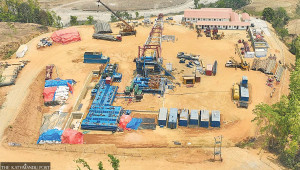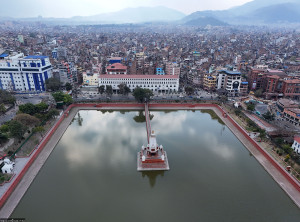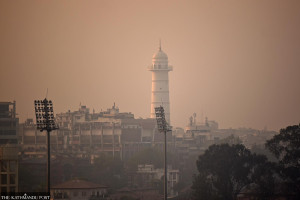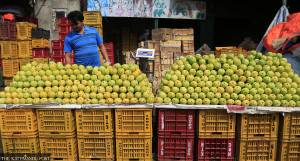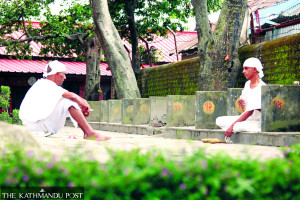Culture & Lifestyle
A labour of love and tradition in Newa cuisine
Takha, a Newa winter delicacy, is a gelatinous dish made from buffalo meat (especially skin), embodying tradition and meticulous craftsmanship.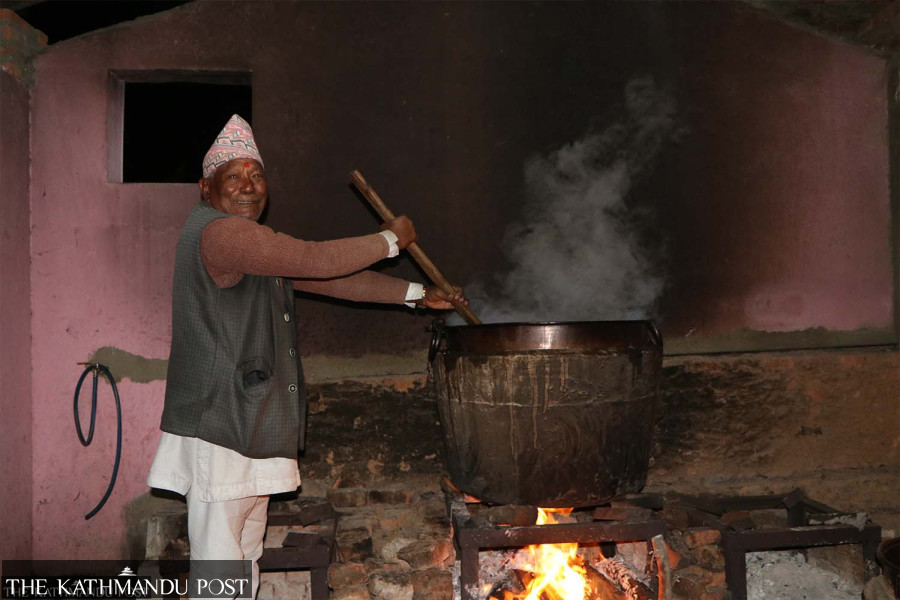
Timila Maharjan
Seventy-six-year-old Bir Krishna Maharjan has more than 50 years of experience in preparing Takha. He has worked as the Mu Bhalin (head cook) on various occasions and feasts organised by the Guthi and the community members.
Takha is a Newa delicacy made by boiling buffalo meat (mainly skin, flesh and cartilage from the head, neck and other parts), which is not used in other meat dishes. It is boiled in water and spices for several hours, which is later set to cool overnight to turn the broth into jelly texture. There are two categories of Takha—Maa Takha and Sanyakhuna. Maa Takha is non-spicy Takha, whereas Sanyakhuna (Sanya means dried anchovy) is spicy and made using dried anchovy. Red chilli powder, dried anchovy, and other ingredients are added to the broth of Maa Takha to prepare Sanyakhuna.
Sanyakhuna is also normally called Paalu Takha, which translates to spicy Takha. They are famous Newa Cuisine dishes, usually prepared during the winter season from November to March.
Maharjan lights his cigarette and the stove's wood to boil the water to prepare Takha. It is the first step of preparation. He has been preparing it since his childhood. He doesn’t exactly remember when he started cooking Takha, but it has been over 50 years. He says, “I learned it by observing others prepare it in the guthi (a communal place of Newa community) and feasts when I was a child. Later, I began to assist the cooks and gradually took the lead in its preparation.”
As an experienced cook, Maharjan is leading and overseeing the Takha preparation in the Punhi Guthi this year as well, although the head cook is from another household. Each year, a guthi member is designated as the head cook, chosen from the previous year’s Gu: Paa household—the household responsible for organising the jatra, conducting the puja, and hosting feasts for the guthi. This responsibility is rotated among guthi members’ households in turn. Other guthi members are assigned as assistant cooks to support the head cook in the preparations. Since only men from each family are eligible to become guthi members, all the cooks involved are men.
Aside from guthi, Takha is also prepared for feasts on different occasions and at home. Nowadays, Takha has also been commercialised and is seen being sold in Newa eateries as well. Gyanendra Maharjan, one of the members of Punhi Guthi says, “The taste of Takha sold in shops and ones made in guthi are very different. In guthi, the broth is boiled for several hours (12-14), and rigorous labour is required. But, in eateries, the broth is boiled for less time. Thus, the richness and depth of the Takha is not found in them.” He added, “The demand for Takha started to increase, and local eateries also started to sell it, as it is only prepared occasionally in Guthi and is a tedious job to prepare at home.”

In the guthi, preparing Takha starts in the early morning when a big pot is filled with water to boil. Bir Krishna says, “We started boiling the water at 7:00 am, and the water started to boil at noon.” Punhi Guthi uses a big pot with a capacity of 300 litres to prepare the broth. The meat and bones are added to the water only after it is boiled. The bones are boiled by keeping them inside the sack and are later removed. Then, after the meat is cooked, oil and other spices are added to the broth.
Maa Takha requires only a few spices, like salt, mustard oil, cumin powder, and a pinch of turmeric. Rock salt is used instead of iodised salt as it is believed to give a better taste and is better than iodised salt. A Fennel plant is also added to add a slight green colour to the Maa Takha.
After the Maa Takha is cooked, a small puja is done by the thakali (eldest) of the guthi, wishing the Takha to be delicious and rewarding the intensive labour of the whole day.
Later, some portion of the broth of Maa Takha is transferred into another pot to prepare Sanyakhuna. Then, the broth for Maa Takha is transferred into small bowls and kept in a different room to let it sit and freeze overnight. Before transferring the broth, the bowls are heated in the fire. It ensures that the broth properly freezes the next day.
Additional ingredients are added to the broth of Maa Takha to prepare Sanyakhuna. Dried anchovy is fried in hot oil where different herbs, juice of rough lemon, ginger garlic paste, asafoetida (hing), black salt, and chilli powder are added to the oil. Later the mixture is added to the broth and is boiled again for a certain period.
Finally, at the end, the broth of Sanyakhuna is transferred into small bowls to cool down and freeze, which later gelifies. More chunks of meat are added to Maa Takha than in Sanyakhuna, as dried anchovies are added. After the end of Takha preparation, all the cooks sit together and taste the broth.

Bir Krishna says that about 300 litres of water was used to prepare both Takha. To prepare it about 28-30 dharni meat, 2 pathi oil and 250 kgs of firewood were used.
He says the remaining meat is used in Takha after cooking other meat dishes. Buffalo skin is used primarily to help gelify the broth. The bones are also boiled together in a sack, later removed, and used as firewood. He says, “The bones also burn as the wood. Every part of the buffalo is used in the Takha.” According to him, every guthi slaughtered a whole buffalo and used the meat to prepare takha and other dishes. But now, they buy the meat.
He shares one of his experiences where the head cook of one of the guthi was sceptical about adding spices to the broth of Takha as it was cooked in a huge pot. So, he suggested Bir Krishna add the spices, which made the Takha delicious. He was praised a lot for making Takha so delicious. Gyanendra says, “It is tricky to add the right amount of spices to the Takha as it is cooked in a large amount. The cooks use their hunch and experience to prepare the perfect Takha. Not everyone can prepare delicious Takha.”
In the Newa community, Takha and Sanyakhuna are usually prepared during different occasions and feast in winter. In Thecho, it is generally prepared on the day of Yomari Punhi and then distributed among the guthi members the next day.
Thecho Jatra starts from the day before Yomari Punhi, where the guthi of Thecho prepares Takha for its feast. Punhi Guthi used to prepare Takha on the day of Yomari Punhi as well, but in a few years, they started to prepare it the day before so that people could enjoy Takha and Sanyakhuna from the first day of Jatra.
One of the guthiyar of Punhi Guthi says, “Other guthis of Thecho prepare Takha in even larger and bigger pots as they have more members. In Punhi Guthi, we only prepare Takha for 28 members. Each member gets one Maa Takha and one Sanyakhuna. Distributing Takha to the guthi members is new and has just been 10-12 years. Otherwise, it was only served in the feast organised by the guthi. Besides guthi, people prepare Takha in different feasts. Nowadays, it is also sold in local eateries. Gyanendra says, “Later, the demand for Takha increased as it is prepared occasionally in guthi, feast and is a tedious job to prepare at home.”
Bir Krishna says, “Ma Takha is a healthy dish suitable for sick people as well. It is considered good for health.”
Gyanendra says, “ Although cooking Takha in guthi usually takes 12-14 hours, the time also depends on the buffalo's age. The younger the Buffalo, the easier it is to cook the meat.”
The art of preparing Takha reflects the Newa community’s deep-rooted culinary traditions and cultural values. For experts like Bir Krishna, this isn’t just about cooking; it is a testament to their heritage, preserved and passed down over generations. The labour-intensive process, communal participation, and meticulous attention to detail make Takha more than just a dish—it celebrates craftsmanship and collective effort.




 22.33°C Kathmandu
22.33°C Kathmandu











